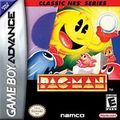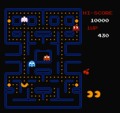(moved box art galleries to this page.) |
|||
| Line 1: | Line 1: | ||
{{All Game Nav|game=Pac-Man}} | {{All Game Nav|game=Pac-Man}} | ||
== Apple II == | == Apple II == | ||
[[Image:PM_AP2_Maze.gif|thumb|left| | [[Image:PM_AP2_Maze.gif|thumb|left|screen]] | ||
Developed by Atarisoft in 1983. | [[Image:PM AP2 box.jpg|thumb|120px|right|box]] | ||
Developed by Atarisoft in 1983. Originally written by Brian Fitzgerald and released as Taxman by H.A.L. Labs. Atari first threatened to sue Fitzgerald and H.A.L., but later bought the program and re-released it as Pac-Man. | |||
{{-}} | {{-}} | ||
== Atari 2600 == | == Atari 2600 == | ||
Developed by Atari in 1981. The official Atari 2600 version of Pac-Man is considered by many to be the worst Pac-Man conversion made. The only bonus prize is a vitamin that appears beneath the ghost pen periodically. Rather than strecth the maze like other versions, the Atari 2600 implementation turns the maze on it's side, so the tunnels are at the top and the bottom. An extra life is granted every time the board is cleared, regardless of points. The cartridge features 8 variations by presenting the player with 4 choices for the ghost speed, and 2 choices for the player's speed. The ghosts' behaviors are broken down as a permutation of smart/dumb, and slow/fast. More details about the differences between the arcade version and the Atari 2600 version can be found at [http://en.wikipedia.org/wiki/Pac-Man_(Atari_2600) wikipedia] | Developed by Atari in 1981. The official Atari 2600 version of Pac-Man is considered by many to be the worst Pac-Man conversion made. The only bonus prize is a vitamin that appears beneath the ghost pen periodically. Rather than strecth the maze like other versions, the Atari 2600 implementation turns the maze on it's side, so the tunnels are at the top and the bottom. An extra life is granted every time the board is cleared, regardless of points. The cartridge features 8 variations by presenting the player with 4 choices for the ghost speed, and 2 choices for the player's speed. The ghosts' behaviors are broken down as a permutation of smart/dumb, and slow/fast. More details about the differences between the arcade version and the Atari 2600 version can be found at [http://en.wikipedia.org/wiki/Pac-Man_(Atari_2600) wikipedia] | ||
<gallery> | |||
Image:PM_2600_Maze.png|screen | |||
Image:PM 2600 Atari box.jpg|Atari box | |||
Image:PM 2600 Sears box.jpg|Sears box | |||
</gallery> | |||
{{-}} | {{-}} | ||
== Atari 5200 & 400/800/XL/XE == | == Atari 5200 & 400/800/XL/XE == | ||
Developed by Atari in 1982. Even though Atari dropped the ball when it came to the 2600 version, the Atari 8-bit line of computers was treated to one of the most accurate conversions available. The only thing glaringly different is that Bashful is green instead of blue, the Galaxian prize was changed to the Atari logo, and the maze is stretch out to fill up the television screen. Every other aspect of the game is faithfully reproduced, including the intermissions. The Atari 5200 version is identical, with the exception of the controls being difficult to use. | Developed by Atari in 1982. Even though Atari dropped the ball when it came to the 2600 version, the Atari 8-bit line of computers was treated to one of the most accurate conversions available. The only thing glaringly different is that Bashful is green instead of blue, the Galaxian prize was changed to the Atari logo, and the maze is stretch out to fill up the television screen. Every other aspect of the game is faithfully reproduced, including the intermissions. The Atari 5200 version is identical, with the exception of the controls being difficult to use. | ||
<gallery> | |||
Image:PM_5200_Maze.gif|screen | |||
Image:PM 5200 box.jpg|5200 box | |||
Image:PM 800 box.jpg|400/800 box | |||
</gallery> | |||
{{-}} | {{-}} | ||
== ColecoVision == | == ColecoVision == | ||
| Line 19: | Line 26: | ||
{{-}} | {{-}} | ||
== Commodore 64 == | == Commodore 64 == | ||
[[Image:PM C64 Maze.gif|thumb|left| | [[Image:PM C64 Maze.gif|thumb|left|screen]] | ||
[[Image:PM C64 Atarisoft box.jpg|thumb|120px|right|box]] | |||
Developed by Atarisoft in 1983. This version is nearly identical to the Atari 8-bit conversion. | Developed by Atarisoft in 1983. This version is nearly identical to the Atari 8-bit conversion. | ||
{{-}} | {{-}} | ||
== Commodore VIC-20 == | == Commodore VIC-20 == | ||
[[Image:PM V20 Maze.png|thumb|left| | [[Image:PM V20 Maze.png|thumb|left|screen]] | ||
[[Image:PM VIC20 box.jpg|thumb|120px|right|box]] | |||
Developed by Atarisoft in 1983. Due to the resolution of the VIC-20, this version features a simplified maze. Commodore and HAL Laboratory released a game for the VIC-20 called Jelly Monsters which was a more faithful conversion of Pac-Man... however, Commodore was forced to halt sales of the game due to copyright violations. | Developed by Atarisoft in 1983. Due to the resolution of the VIC-20, this version features a simplified maze. Commodore and HAL Laboratory released a game for the VIC-20 called Jelly Monsters which was a more faithful conversion of Pac-Man... however, Commodore was forced to halt sales of the game due to copyright violations. | ||
{{-}} | {{-}} | ||
== Fujitsu FM-7 == | == Fujitsu FM-7 == | ||
[[ Image:Pac-Man FM-7.png|thumb|left| | [[Image:Pac-Man FM-7.png|thumb|left|screen]] | ||
[[Image:Pac-Man_FM-7_box.jpg|120px|thumb|right|box]] | |||
This version of Japan-only conversion of Pac-Man for the Fujitsu FM-7 home computer was released in 1984. To account for the difference in screen size, the maze was rotated 90 degrees counter-clockwise. The speed is considered somewhat slow. | This version of Japan-only conversion of Pac-Man for the Fujitsu FM-7 home computer was released in 1984. To account for the difference in screen size, the maze was rotated 90 degrees counter-clockwise. The speed is considered somewhat slow. | ||
{{-}} | {{-}} | ||
== Game Boy == | == Game Boy == | ||
[[Image:PM GB Maze.gif|thumb|left| | [[Image:PM GB Maze.gif|thumb|left|screen]] | ||
[[Image:PM GB box.jpg|thumb|120px|right|box]] | |||
Developed by Namco in 1991. You can choose between two views when you play, a full sized view that scrolls, and a half sized view that fits the whole screen. All of the ghosts are the same color, and therefore indistinguishable by sight alone. | Developed by Namco in 1991. You can choose between two views when you play, a full sized view that scrolls, and a half sized view that fits the whole screen. All of the ghosts are the same color, and therefore indistinguishable by sight alone. | ||
{{-}} | {{-}} | ||
== Game Boy Color == | == Game Boy Color == | ||
[[Image:PM GBC Maze.png|thumb|left| | [[Image:PM GBC Maze.png|thumb|left|screen]] | ||
[[Image:PM GBC box.jpg|120px|thumb|right|box]] | |||
Developed by Namco in 1999. This is a color corrected version of the original Game Boy conversion. Other than the addition of color, the gameplay is identical to the regular Game Boy's. It does, however, come included with a GBC conversion of Pac-Attack which is a Tetris variant. | Developed by Namco in 1999. This is a color corrected version of the original Game Boy conversion. Other than the addition of color, the gameplay is identical to the regular Game Boy's. It does, however, come included with a GBC conversion of Pac-Attack which is a Tetris variant. | ||
{{-}} | |||
== Game Boy Advance == | |||
<gallery> | |||
Image:PM GBA NES box.jpg|Classic NES box | |||
Image:PM GBA JP box.jpg|Famicom Mini box | |||
Image:PMC GBA box.jpg|Pac-Man Collection box | |||
</gallery> | |||
{{-}} | {{-}} | ||
== Intellivision == | == Intellivision == | ||
Developed by Atarisoft in 1983. The maze isn't quite perfect and the gameplay is a little slow. Despite that, Atarisoft developed a rather accurate port for the Intellivision. The sound is particularly close, and even the intermissions are included. | Developed by Atarisoft in 1983. The maze isn't quite perfect and the gameplay is a little slow. Despite that, Atarisoft developed a rather accurate port for the Intellivision. The sound is particularly close, and even the intermissions are included. | ||
<gallery> | |||
Image:PM INTV Maze.gif|screen | |||
Image:PM INTV box.jpg|original box | |||
Image:PM INTV2 box.jpg|rerelease | |||
</gallery> | |||
{{-}} | {{-}} | ||
== MSX == | == MSX == | ||
| Line 48: | Line 70: | ||
{{-}} | {{-}} | ||
== NeoGeo Pocket Color == | == NeoGeo Pocket Color == | ||
[[Image:PM NGPC Maze.gif|thumb|left| | [[Image:PM NGPC Maze.gif|thumb|left|screen]] | ||
[[Image:PM NGPC box.jpg|thumb|120px|right|box]] | |||
Developed by Namco in 1999. You can choose between two views when you play, a full sized view that scrolls, and a half sized view that fits the whole screen. All aspects of gameplay are faithfully reproduced. This version is so accurate in fact, that many of the arcade patterns will actually work with this version. The only drawback is the controller's tendancy to hit diagonals. To offset that, the cartridge is shiped with rubber rings that restrict the movement of the joystick to 4 directions. | Developed by Namco in 1999. You can choose between two views when you play, a full sized view that scrolls, and a half sized view that fits the whole screen. All aspects of gameplay are faithfully reproduced. This version is so accurate in fact, that many of the arcade patterns will actually work with this version. The only drawback is the controller's tendancy to hit diagonals. To offset that, the cartridge is shiped with rubber rings that restrict the movement of the joystick to 4 directions. | ||
{{-}} | {{-}} | ||
== NES == | == NES == | ||
Developed by Namco in 1984. This version takes the formula established by the MSX version and corrects many of the color issues that were due to graphical limitations of the MSX. Due to the reduced size of the maze, there are fewer dots to eat, but the rest of the game play mechanics are faithful to the arcade version. In the United States, Namco's port was licensed to Tengen and released in 1987. After Tengen was sued by Nintendo, Namco rereleased the title, side by side with a Ms. Pac-Man release, in 1993. | Developed by Namco in 1984. This version takes the formula established by the MSX version and corrects many of the color issues that were due to graphical limitations of the MSX. Due to the reduced size of the maze, there are fewer dots to eat, but the rest of the game play mechanics are faithful to the arcade version. In the United States, Namco's port was licensed to Tengen and released in 1987. After Tengen was sued by Nintendo, Namco rereleased the title, side by side with a Ms. Pac-Man release, in 1993. | ||
<gallery> | |||
Image:PM NES Maze.png|screen | |||
Image:PM FC box.jpg|Famicom box | |||
Image:PM NES Tengen box.jpg|Tengen box | |||
Image:PM NES Namco box.jpg|Namco box | |||
</gallery> | |||
{{-}} | |||
== PC == | |||
<gallery> | |||
Image:Pac-Man IBM box.jpg|Atarisoft box | |||
Image:PM Thunder Mountain box.jpg|Thunder Mountain box (also for C64) | |||
</gallery> | |||
{{-}} | {{-}} | ||
== Sega Gamegear == | == Sega Gamegear == | ||
[[Image:PM SGG Maze.png|thumb|left| | [[Image:PM SGG Maze.png|thumb|left|screen]] | ||
[[Image:PM SGG box.jpg|thumb|120px|right|box]] | |||
Developed by Namco in 1990. You can choose between two views when you play, a full sized view that scrolls, and a half sized view that fits the whole screen. All aspects of gameplay are faithfully reproduced. | Developed by Namco in 1990. You can choose between two views when you play, a full sized view that scrolls, and a half sized view that fits the whole screen. All aspects of gameplay are faithfully reproduced. | ||
{{-}} | {{-}} | ||
== TI-99/4A == | == TI-99/4A == | ||
[[Image:PM TI99 Maze.png|thumb|left| | [[Image:PM TI99 Maze.png|thumb|left|screen]] | ||
[[Image:PM TI99 box.jpg|thumb|120px|right|box]] | |||
Developed by Atarisoft in 1983. | Developed by Atarisoft in 1983. | ||
{{-}} | {{-}} | ||
Revision as of 03:12, 2 May 2007
Apple II
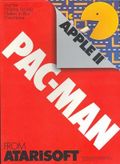
Developed by Atarisoft in 1983. Originally written by Brian Fitzgerald and released as Taxman by H.A.L. Labs. Atari first threatened to sue Fitzgerald and H.A.L., but later bought the program and re-released it as Pac-Man.
Atari 2600
Developed by Atari in 1981. The official Atari 2600 version of Pac-Man is considered by many to be the worst Pac-Man conversion made. The only bonus prize is a vitamin that appears beneath the ghost pen periodically. Rather than strecth the maze like other versions, the Atari 2600 implementation turns the maze on it's side, so the tunnels are at the top and the bottom. An extra life is granted every time the board is cleared, regardless of points. The cartridge features 8 variations by presenting the player with 4 choices for the ghost speed, and 2 choices for the player's speed. The ghosts' behaviors are broken down as a permutation of smart/dumb, and slow/fast. More details about the differences between the arcade version and the Atari 2600 version can be found at wikipedia
-
screen
-
Atari box
-
Sears box
Atari 5200 & 400/800/XL/XE
Developed by Atari in 1982. Even though Atari dropped the ball when it came to the 2600 version, the Atari 8-bit line of computers was treated to one of the most accurate conversions available. The only thing glaringly different is that Bashful is green instead of blue, the Galaxian prize was changed to the Atari logo, and the maze is stretch out to fill up the television screen. Every other aspect of the game is faithfully reproduced, including the intermissions. The Atari 5200 version is identical, with the exception of the controls being difficult to use.
-
screen
-
5200 box
-
400/800 box
ColecoVision
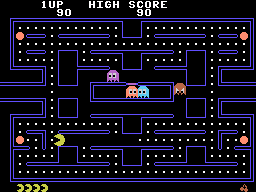
Developed by Atarisoft in 1983 but unreleased. The prototype rom was discovered and released to the public. The port is extremely accurate, possibly surpassing even Atari's own 8-bit conversion (which, it has been suggested, is the reason it was not released.) Opcodegames.com is preparing to release a homebrew Colecovision game which includes versions of Pac-Man, Pac-Man Plus, and Ms. Pac-Man which are heavily inspired by the MSX2 conversions.
Commodore 64

Developed by Atarisoft in 1983. This version is nearly identical to the Atari 8-bit conversion.
Commodore VIC-20
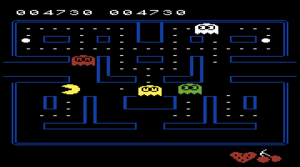
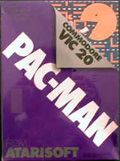
Developed by Atarisoft in 1983. Due to the resolution of the VIC-20, this version features a simplified maze. Commodore and HAL Laboratory released a game for the VIC-20 called Jelly Monsters which was a more faithful conversion of Pac-Man... however, Commodore was forced to halt sales of the game due to copyright violations.
Fujitsu FM-7
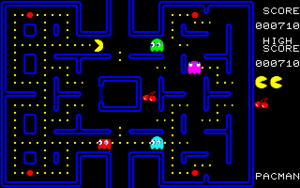
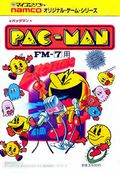
This version of Japan-only conversion of Pac-Man for the Fujitsu FM-7 home computer was released in 1984. To account for the difference in screen size, the maze was rotated 90 degrees counter-clockwise. The speed is considered somewhat slow.
Game Boy
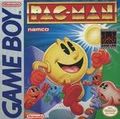
Developed by Namco in 1991. You can choose between two views when you play, a full sized view that scrolls, and a half sized view that fits the whole screen. All of the ghosts are the same color, and therefore indistinguishable by sight alone.
Game Boy Color
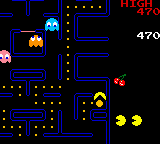

Developed by Namco in 1999. This is a color corrected version of the original Game Boy conversion. Other than the addition of color, the gameplay is identical to the regular Game Boy's. It does, however, come included with a GBC conversion of Pac-Attack which is a Tetris variant.
Game Boy Advance
-
Classic NES box
-
Famicom Mini box
-
Pac-Man Collection box
Intellivision
Developed by Atarisoft in 1983. The maze isn't quite perfect and the gameplay is a little slow. Despite that, Atarisoft developed a rather accurate port for the Intellivision. The sound is particularly close, and even the intermissions are included.
-
screen
-
original box
-
rerelease
MSX
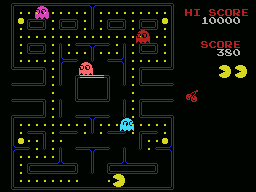
Developed by Namco in 1984. This is the first home conversion directly developed by Namco for any other system. It pioneered the use of a reduced maze with the correct aspect ratio and score display on the side that is still in use today by Namco's classic compilation disks and the TV Plug N' Play games.
NeoGeo Pocket Color
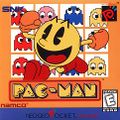
Developed by Namco in 1999. You can choose between two views when you play, a full sized view that scrolls, and a half sized view that fits the whole screen. All aspects of gameplay are faithfully reproduced. This version is so accurate in fact, that many of the arcade patterns will actually work with this version. The only drawback is the controller's tendancy to hit diagonals. To offset that, the cartridge is shiped with rubber rings that restrict the movement of the joystick to 4 directions.
NES
Developed by Namco in 1984. This version takes the formula established by the MSX version and corrects many of the color issues that were due to graphical limitations of the MSX. Due to the reduced size of the maze, there are fewer dots to eat, but the rest of the game play mechanics are faithful to the arcade version. In the United States, Namco's port was licensed to Tengen and released in 1987. After Tengen was sued by Nintendo, Namco rereleased the title, side by side with a Ms. Pac-Man release, in 1993.
-
screen
-
Famicom box
-
Tengen box
-
Namco box
PC
-
Atarisoft box
-
Thunder Mountain box (also for C64)
Sega Gamegear
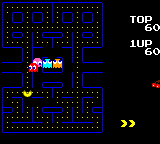

Developed by Namco in 1990. You can choose between two views when you play, a full sized view that scrolls, and a half sized view that fits the whole screen. All aspects of gameplay are faithfully reproduced.
TI-99/4A
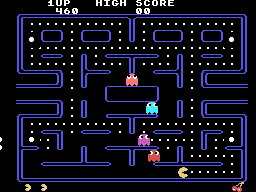
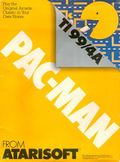
Developed by Atarisoft in 1983.
Windows 9x
Developed by Microsoft as part of Microsoft Return of Arcade (1996) and Microsoft Return of Arcade Anniversary Edition (2000). Unlike most other versions, this was entirely reprogrammed to simulate the original, rather than being based on the arcade version's code. The menus contained the original's dip switch settings.
Noteworthy
Atari 2600
Because so many people were disappointed by the official Atari 2600 version, some hackers have tried to make up for the lack of a proper Pac-Man conversion. There are two rom hacks which have succeeded in bringing a more faithful version of the game to this system. One is a hack of the Ms. Pac-Man game done initially by Rob Kudla, and improved upon by "El Destructo," called Mr. Pac-Man which uses the Ms. Pac-Man code as a basis to reproduce Pac-Man rather successfully. The other is a hack of the Ebivision game called Pesco which was released in 1999. Pesco began life as a faithful conversion of Pac-Man, but was changed at the last minute to avoid a lawsuit. Since then, a hacker named Nukey Shay has been diligently converting the rom back to Pac-Man, and even improving on the original plan by adding Pac-Man Plus and Hanglyman derivations of the game to the rom.
Atari 7800
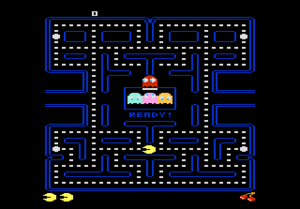
A dedicated AtariAge.com forum member who goes by the nickname PacManPlus has hacked the original Ms. Pac-Man rom in to, not only Pac-Man, but a number of Pac-Man related projects like Pac-Man Plus, Hanglyman, Ms. Pac-Attack (a hack of the original Ms. Pac-Man arcade that altered the maze layouts), a multiple maze version called Ultra Pac-Man, and most recently, a compilation cartridge containing just about all of the above. PacManPlus did more than just alter the maze and colors, he's updated the graphics and taken many beta tester's suggestions in to consideration to make the most accurate conversion possible.
Bally Astrocade
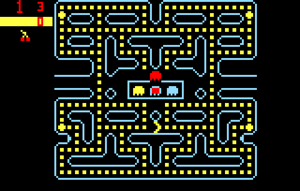
Bally released a conversion of Pac-Man for their Astrocade console. While they owned the arcade rights to Pac-Man, they did not own the home console rights, so they changed the name of the game to Muncher, and then ultimately did not release it for commercial sale. It is extremely accurate despite the poor resolution ability of the system, and features the maze in the correct aspect ratio.
Commodore VIC-20

While Atari had the rights to release Pac-Man for computers in the United States, HAL Laboratories had the rights in Japan. They created this version of the game which was clearly more accurate than the Atarisoft version. Commodore changed the name to Jelly Monster to avoid legal problems, but Atari still tried to pressure the game out of the market.
Odyssey2
Magnavox developed the famous "Pac-Man game that wasn't Pac-Man" called K.C. Munchkin. K.C. was blue and was chased by three ghosts. He had to gobble up 12 dots (4 of which were power pellets) that wandered endlessly throughout the maze. As K.C. ate each dot, the rest sped up. K.C. only had one life in the game, and he didn't have a long life on the shelf either after Atari sued Magnavox over K.C.'s similarity to Pac-Man and won.





